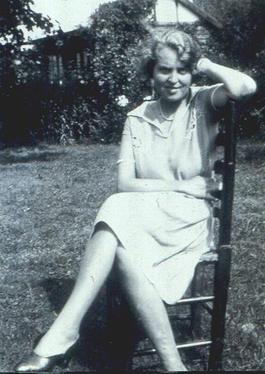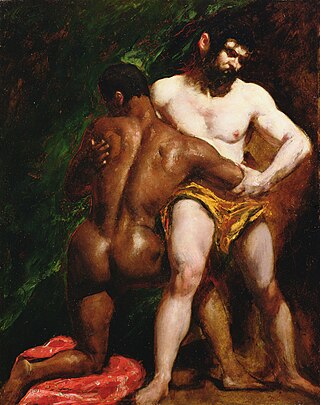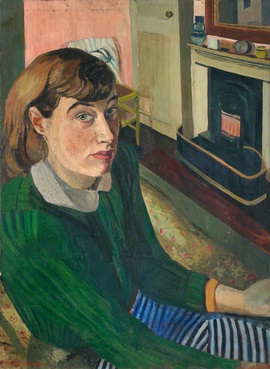Related Research Articles

Thomas Gainsborough was an English portrait and landscape painter, draughtsman, and printmaker. Along with his rival Sir Joshua Reynolds, he is considered one of the most important British artists of the second half of the 18th century. He painted quickly, and the works of his maturity are characterised by a light palette and easy strokes. Despite being a prolific portrait painter, Gainsborough gained greater satisfaction from his landscapes. He is credited as the originator of the 18th-century British landscape school. Gainsborough was a founding member of the Royal Academy.

Walter Richard Sickert was a German-born British painter and printmaker who was a member of the Camden Town Group of Post-Impressionist artists in early 20th-century London. He was an important influence on distinctively British styles of avant-garde art in the mid- and late 20th century.

Lucian Michael Freud was a British painter and draughtsman, specialising in figurative art, and is known as one of the foremost 20th-century English portraitists. He was born in Berlin, the son of Jewish architect Ernst L. Freud and the grandson of Sigmund Freud. Freud got his first name "Lucian" from his mother in memory of the ancient writer Lucian of Samosata. His family moved to England in 1933, when he was 10 years old, to escape the rise of Nazism. He became a British naturalized citizen in 1939. From 1942 to 1943 he attended Goldsmiths College, London. He served at sea with the British Merchant Navy during the Second World War.

Sir Stanley Spencer, CBE RA was an English painter. Shortly after leaving the Slade School of Art, Spencer became well known for his paintings depicting Biblical scenes occurring as if in Cookham, the small village beside the River Thames where he was born and spent much of his life. Spencer referred to Cookham as "a village in Heaven" and in his biblical scenes, fellow-villagers are shown as their Gospel counterparts. Spencer was skilled at organising multi-figure compositions such as in his large paintings for the Sandham Memorial Chapel and the Shipbuilding on the Clyde series, the former being a First World War memorial while the latter was a commission for the War Artists' Advisory Committee during the Second World War.
Events from the year 1937 in art.

Henry Taylor Lamb was an Australian-born British painter. A follower of Augustus John, Lamb was a founder member of the Camden Town Group in 1911 and of the London Group in 1913.

George Spencer Watson R.O.I., R.P., A.R.A., R.A. was an English portrait artist of the late romantic school who sometimes worked in the style of the Italian Renaissance.

Stanley is a 1996 play written by English playwright, Pam Gems. The play was premiered at the Royal National Theatre's Cottesloe Theatre in London.

Gilbert Spencer was a British painter of landscapes, portraits, figure compositions and mural decorations. He worked in oils and watercolour. He was the younger brother of the painter Stanley Spencer.

A Bigger Splash is a large pop art painting by British artist David Hockney. Measuring 242.5 centimetres (95.5 in) by 243.9 centimetres (96.0 in), it depicts a swimming pool beside a modern house, disturbed by a large splash of water created by an unseen figure who has apparently just jumped in from a diving board. It was painted in California between April and June 1967, when Hockney was teaching at the University of California, Berkeley. Jack Hazan's fictionalised 1973 biopic, A Bigger Splash, concentrating on the breakup of Hockney's relationship with Peter Schlesinger, was named after the painting.

Patricia Preece, Lady Spencer, born Ruby Vivian Preece, was an English artist, associated with the Bloomsbury Group, and the second wife of painter Stanley Spencer, for whom she modelled. It was later discovered that nearly all of the artwork exhibited and sold by Preece was painted by her lifelong lover, Dorothy Hepworth.

August Blue is an oil-on-canvas painting by British artist Henry Scott Tuke. It depicts four youths in and around a boat, bathing in the sea. Tuke started the painting in 1893, probably en plein air on a boat in the harbour at Falmouth, Cornwall. The finished painting was exhibited at the Royal Academy summer exhibition in 1894, and immediately purchased for the Tate Gallery, where it remains to this day. It has a light Impressionistic style, possibly influenced by his travels to Italy, Corfu and Albania in 1892.

Hilda Anne Carline (1889–1950) was a British painter, daughter of the artist George Francis Carline, and first wife of the artist Stanley Spencer. She studied art under the Post-Impressionist Percyval Tudor-Hart, with her brothers Sydney and Richard, and then at the Slade School of Art under Henry Tonks. She had a promising early start with her works being shown at the London Group, Royal Academy and New English Art Club.

Candaules, King of Lydia, Shews his Wife by Stealth to Gyges, One of his Ministers, as She Goes to Bed, occasionally formerly known as The Imprudence of Candaules, is a 45.1 by 55.9 cm oil painting on canvas by English artist William Etty, first exhibited at the Royal Academy in 1830. It shows a scene from the Histories by Herodotus, in which Candaules, king of Lydia, invites his bodyguard Gyges to hide in the couple's bedroom and watch his wife Nyssia undress, to prove to him her beauty. Nyssia notices Gyges spying and challenges him to either accept his own execution or to kill Candaules as a punishment. Gyges chooses to kill Candaules and take his place as king. The painting shows the moment at which Nyssia, still unaware that she is being watched by anyone other than her husband, removes the last of her clothes.

The Wrestlers is an oil painting on millboard by English artist William Etty, painted around 1840 and currently in the York Art Gallery, in York, England. It depicts a wrestling match between a black man and a white man, both glistening with sweat and under an intense light emphasising their curves and musculature. While little documentation of the painting exists prior to 1947, it is likely that it was painted over a period of three evenings at the life class of the Royal Academy.

Musidora: The Bather 'At the Doubtful Breeze Alarmed', also known as The Bather, is a name given to four nearly identical oil paintings on canvas by English artist William Etty. The paintings illustrate a scene from James Thomson's 1727 poem Summer in which a young man accidentally sees a young woman bathing naked, and is torn between his desire to look and his knowledge that he ought to look away. The scene was popular with English artists as it was one of the few legitimate pretexts to paint nudes at a time when the display and distribution of nude imagery was suppressed.
Nancy Mona Carline, was a British artist who painted landscapes with figures, portraits, biblical and classical subjects plus groups of figures in domestic settings. She studied at the Slade School of Art and worked at the Sadlers Wells Ballet and later attended the stage design course at the Slade run by Vladimir Polunin. In 1950 she married the artist Richard Carline, which placed her at the centre of an artistic circle centred on the Carline family in Hampstead.

Dorothy Mary Hepworth was a British painter and the life partner of Patricia Preece. Hepworth signed Preece's name to many of Hepworth's paintings, even after Preece's death.

Auguste Renoir painted two very similar versions of Blonde Bather in 1881 and 1882. The model was Aline Charigot, later to become Renoir's wife. Influenced by Renaissance painting that Renoir saw in Italy in 1881, both paintings show a marked change of style from Renoir's previous work. Some commentators consider these are works of great beauty, others that they are vulgar. There has been criticism of the conservation work performed on the 1881 painting.

Daphne Charlton was a British artist.
References
- ↑ Exhibition at the Tate in 2001; Room 3: Forsaking the Vision
- ↑ Double Nude Portrait: The Artist and his Second Wife, Illustrated Companion, Tate Gallery
- ↑ "BBC Four - Arena, Stanley and his Daughters".